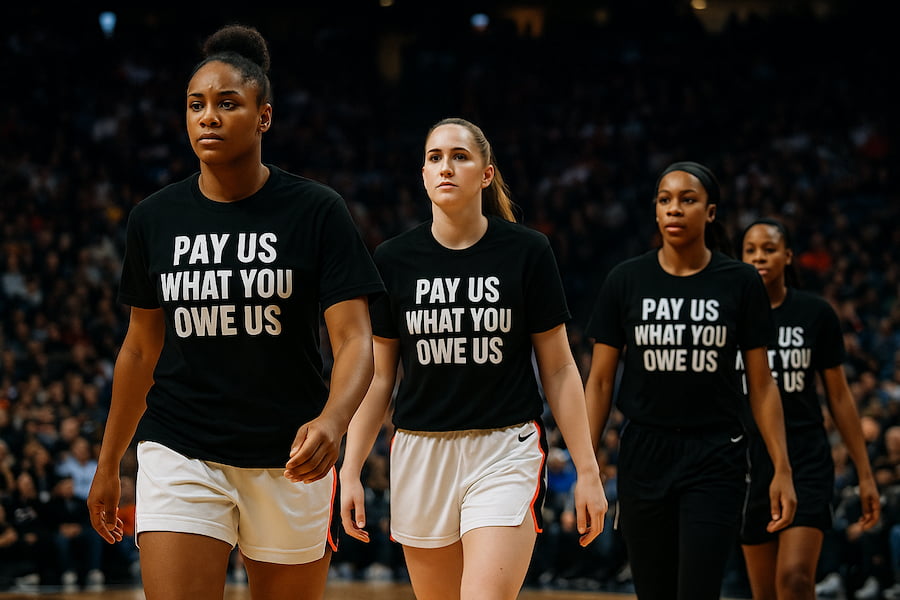
Inside the WNBA’s $1 Million Salary Fight
The 2025 WNBA All-Star Game in Indianapolis was supposed to be a victory lap. Attendance had doubled. A record-setting $2.2 billion media rights deal was about to take effect. And the sport’s rising star, Caitlin Clark, was set to headline a celebration in her hometown.
But celebration gave way to controversy. Clark sat out due to injury. A Shane Gillis joke at the ESPYs sparked backlash. And during warmups, players donned shirts reading: “Pay Us What You Owe Us”, a not-so-subtle message during high-stakes collective bargaining agreement (CBA) negotiations.
The players’ message is clear: the league is growing, and they want a piece of it. What’s less clear, at least from the outside, is how complicated that demand truly is.
What Players Are Actually Demanding
Contrary to popular misconception, WNBA stars aren’t calling for LeBron-level contracts. Instead, they’re asking for:
- A larger share of league revenue
- Permanent charter flights
- Expanded rosters
- Workplace and family benefits
- And yes, eventually, $1 million salaries
Players like Kelsey Plum and Aliyah Boston have emphasized this is about equity, not parity with the NBA. Their goal: raise the WNBA’s current 10% revenue share closer to the NBA’s ~50% standard.
The League’s Growth — And Losses

The players have a strong case. Growth is undeniable:
- Attendance doubled from the previous year
- The 2024 Finals were the most-watched in 25 years
- The league signed a $2.2B media deal — a historic first
But here’s the catch: the WNBA has never turned a profit. In fact, it lost $40 million last year alone.
Critics argue this makes higher salaries unrealistic. But as with many things in pro sports, the truth lies beneath the balance sheet.
Why the Revenue Split Isn’t as Simple as It Looks
Yes, NBA players receive ~50% of league revenue. But that’s based on basketball-related income (BRI), a carefully defined metric that excludes things like:
- Expansion fees
- Luxury suite sales
- Arena revenue
- Fines and interest income
So even in the NBA, the “50/50 split” isn’t quite what it seems.
And the WNBA’s situation is even more tangled. While the new TV deal is worth $200 million annually, much of that money doesn’t flow directly to the league.
Why? Because the WNBA doesn’t own itself outright.
The Ownership Puzzle: Who Actually Controls the WNBA?
The WNBA’s financial structure is a web of legacy partnerships and outside investors:
- NBA owns ~42%
- WNBA team owners own another ~42%
- A 2022 investor group (including Nike and sports billionaires) owns the remaining ~16%
This means that even though the WNBA signed a $200M/year deal, it doesn’t keep $200M. The revenue is split among multiple stakeholders, and players are last in line.
Other leagues like the NFL and NBA can split revenue more generously with players because they own their assets. The WNBA, by contrast, sold significant equity early on to stay afloat.
The tradeoff? Survive in the short term — but give up long-term control.
Caitlin Clark and the Investment Tipping Point
Caitlin Clark’s arrival supercharged the WNBA’s popularity, but also accelerated pressure from investors. They’ve helped carry the league through lean years, but they now want returns.
The problem: players want raises, but the business side hasn’t yet caught up with the boom in attention.
According to Joe Pompliano, the WNBA was essentially a long-term call option for the NBA — a smart hedge on the future of women’s sports. That bet is now paying off, but the distribution of the winnings is proving contentious.
Will the Players Get $1 Million Salaries?
Eventually, yes — but not immediately. Even WNBA Commissioner Cathy Engelbert has acknowledged the goal is feasible if growth continues. What’s more likely in the short term is:
- Permanent charter flights
- Longer All-Star breaks
- Expanded rosters and benefits
- Gradual increases in top salaries via CBA restructuring
Think of this as the first major bargaining showdown of the modern WNBA era. With real money now on the table, players and owners have more at stake than ever before.
Conclusion: Equity, Not Entitlement

This isn’t about entitlement. It’s about ownership, control, and fairness.
WNBA players have powered the league for nearly 30 years on salaries that pale in comparison to their peers, not just in the NBA, but in overseas leagues where many stars spend offseasons for better pay.
With record-breaking viewership, a transformative rookie class, and a media deal finally worthy of the product, the WNBA is at a turning point.
Yes, players want more money. But the real story? It’s about who controls the future of women’s sports, and who gets to profit from it.
For more interesting updates on the WNBA and beyond, our Sports News USA should keep you up to date with the latest developments in U.S sports.